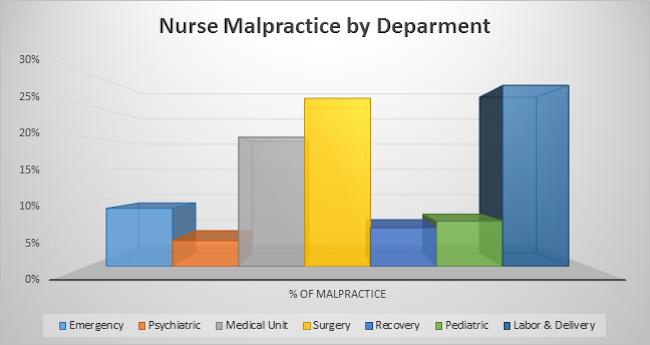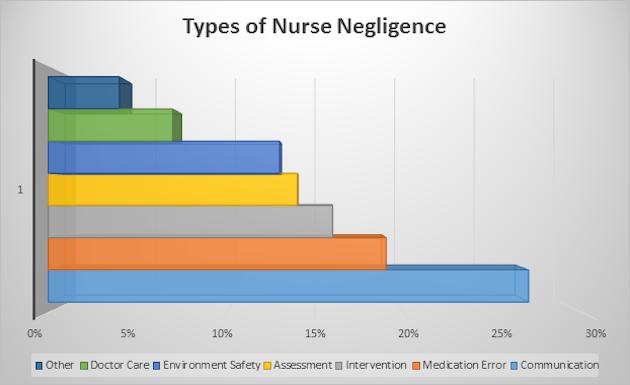 Nurses are licensed health care professionals and can be liable for medical malpractice in the same way as doctors and other health care providers. Of course medical malpractice claims against nurses tend to fall into different categories and involve slightly different circumstances than malpractice claims against doctors. This page will provide a statistical overview of the most common types of medical malpractice claims brought against nurses. Over 75% of all nursing malpractice occurs in the hospital setting so we will focus on malpractice claims involving nursing care in the various departments within the modern hospital.
Nurses are licensed health care professionals and can be liable for medical malpractice in the same way as doctors and other health care providers. Of course medical malpractice claims against nurses tend to fall into different categories and involve slightly different circumstances than malpractice claims against doctors. This page will provide a statistical overview of the most common types of medical malpractice claims brought against nurses. Over 75% of all nursing malpractice occurs in the hospital setting so we will focus on malpractice claims involving nursing care in the various departments within the modern hospital.
Where Does Nursing Negligence Occur?
Negligent nursing care occurs in all hospital departments. However, a review of medical malpractice cases against nurses indicates that nurses in certain departments clearly tend to get sued for malpractice more than others. Keep in mind that this does not necessarily mean that the nurses in these departments are not as good or make more mistakes. It only means that nursing mistakes in certain departs are more prone to result in litigation. This often has more to do with the potential value of malpractice cases in certain contexts and not the quality of nursing care. For instance, nurses in the psychiatric department probably make just as many mistakes as nurses in the surgery department but the psychiatric errors are less likely to cause major injury or death and result in less malpractice cases. 100 incidents of psychiatric nursing negligence may only generate 5 malpractice cases whereas 100 incidents of surgical nursing negligence might generate 30 malpractice claims.

How Does Nursing Malpractice Occur?
Each individual case of nursing malpractice tends to be highly fact specific and unique. However, there are enough general commonalities among nursing malpractice claims to group them into categories. The categories are generally defined by the particular type of nursing negligence alleged: (1) communication; (2) drug errors; (3) intervention; (4) assessment; (5) doctor care; and (6) environmental safety. The chart below shows the rate of occurrence for each category of nursing negligence followed by a more detailed discussion of each type.

- Negligent Communication: negligent communication generally refers to failures to inform doctors of a change in a patient’s condition, abnormal assessment data or other critical information. Communication negligence is the most common type of nursing care problem accounting for just under 30% of all malpractice claims against nurses. Communication tends to be more of a problem in certain departments. Nearly 90% of the communication problems occurred in just 3 clinical departments: labor & delivery (35%); surgery (28%); and emergency (21%). The most common type of negligent communication claim against nurses involved failures to notify doctors of fetal distress during labor. The second most common communication problem involved not reporting a lack of patient improvement prior to discharge. Together these 2 communication problems accounting for just under half (47%) of all communication claims.
- Medication Errors: medication error refers to the negligent or incorrect administration of prescribed drugs to patients. This includes administering the incorrect dose, failing to administer a drug or giving the incorrect drug. Medication negligence is the second leading type of nurse malpractice accounting for roughly 19-20% of malpractice claims against nurses. The occurrence of medication negligence is fairly evenly distributed among the various hospital departments with the largest number (35%) occurring in the medical unit (which includes senior care).
- Negligent Intervention: nursing intervention negligence involves situations where a nurse is somehow negligent in the actual performance of a direct nursing procedure. The most common types of negligent nurse intervention include: improper placement or management of a tube or catheter (23%) and incorrect surgical sponge or instrument preparation (22%). Over half of negligent nurse intervention cases originate from the surgery department.
- Negligent Assessment: negligent assessment refers to cases where a nurse fails to properly assess the
| Medication Errors | Improper administration of prescribed medications (i.e., failure to administer, incorrect dosage, incorrect drug). |
| Negligent Intervention | Failure to properly or skillfully perform a nursing duty or procedure (taking blood, checking vitals, etc.). |
| Negligent Assessment | Failure to properly or accurately assess patient data and condition. |
| Inadequate Doctor Care | Failing to obtain help for a patient when they are not receiving adequate care from a doctor. |
| Environmental Safety | Failure to maintain a secure, safe patient environment. |
 Medical Malpractice
Medical Malpractice





